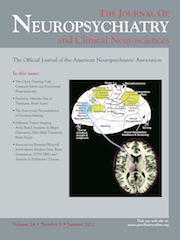Combination Therapy of Zonisamide With Aripiprazole on ECT- and Benzodiazepine-Resistant Periodic Catatonia
To the Editor: Two types of clinical forms of catatonia are established, systematic and periodic catatonia. Periodic catatonia features catatonic stupor alternating with excitement, waxing and waning for years. Systematic catatonia is responsive to benzodiazepine and electroconvulsive therapy (ECT); however, periodic catatonia is poorly responsive to these two major treatments. Here, we report a case of ECT- and benzodiazepine-resistant periodic catatonia in a patient with schizophrenia and the successful treatment of refractory catatonic symptoms with combination therapy of a novel antiepileptic antiparkinsonian agent, zonisamide, and a dopamine D2 receptor partial agonist, aripiprazole.
Case Report
Our case is a 25-year-old man with 2-year history of schizophrenia catatonic type, according to DSM-IV-TR. The patient had previously been admitted 5 times due to stupor and severe positive symptoms. In initial 4 episodes, an increasing dose of haloperidol rapidly improved his positive symptoms; however, in the last episode, the patient had at least 4 recurrent catatonic episodes for 9 months before being transferred to our department. Antipsychotic therapy with risperidone (6 mg/day), olanzapine (10 mg/day), aripiprazole (18 mg/day), and quetiapine (50 mg/day) could not improve the stupor, severe excitement, and positive symptoms. Our laboratory examinations revealed no negative findings. During antipsychotic free conditions, we observed the catatonic stupor alternating with severe excitement. Neither high-dose benzodiazepines nor ECT1 improved the catatonic stupor with excitement. To improve the severe rigidity, zonisamide was titrated up to 600 mg/day. Zonisamide abolished the period of periodic catatonia, but could not affect catatonic stupor. We added aripiprazole (titrated up to 24 mg/day) to zonisamide. The combination therapy of zonisamide with aripiprazole improved catatonic symptoms and prevented the relapse the catatonic stupor alternating with severe excitement for eight-month observation.
Discussion
Two types of clinical forms of catatonia are established, systematic and periodic catatonia.2 Systematic catatonia is responsive to benzodiazepine and ECT; however, periodic catatonia is poorly responsive to these two therapies,2 similar to our case. Antipsychotic monotherapy with aripiprazole, olanzapine, quetiapine or risperidone was not effective; however, zonisamide could prevent the period of periodic catatonia without affecting catatonic stupor. Adding aripiprazole, which did not affect period of periodic catatonia by itself, to zonisamide drastically improved catatonic stupor. Therefore, the combination of zonisamide with aripiprazole drastically improved both period and symptoms of periodic catatonia. Several clinical studies reported the wide clinical spectrum of antiepileptic antiparkinsonian agent, zonisamide, against both psychiatric and neurological disorders, including Parkinson’s disease.3,4 The major mechanisms of clinical action of zonisamide are considered to be an inhibition of voltage-gated sodium channel, monoamine oxidase, ryanodine receptor and radical scavenging action.3 Aripiprazole has unique receptor binding profiles, high affinity with partial agonistic properties against dopamine D2 receptor.5 This successful treatment of combination therapy of zonisamide and aripiprazole against benzodiazepine- and ECT-resistant periodic catatonia suggests that the synergy between neuroprotective and enhanced dopaminergic transmission contribute to the improvement of both period and symptom of periodic catatonia.
1 : Catatonia: a review. Ann Clin Psychiatry 2008; 20:97–107Crossref, Medline, Google Scholar
2 : The many varieties of catatonia. Eur Arch Psychiatry Clin Neurosci 2001; 251(Suppl 1):I8–I13Crossref, Medline, Google Scholar
3 : Different mechanisms underlying the antiepileptic and antiparkinsonian effects of zonisamide, in Epilepsy. Edited by Foyaca-Sibat H. Rijeka, INTECH, 2011 in press.Crossref, Google Scholar
4 : Zonisamide improves motor function in Parkinson disease: a randomized, double-blind study. Neurology 2007; 68:45–50Crossref, Medline, Google Scholar
5 : The importance of 5-HT1A receptor agonism in antipsychotic drug action: rationale and perspectives. Curr Opin Investig Drugs 2010; 11:802–812Medline, Google Scholar



